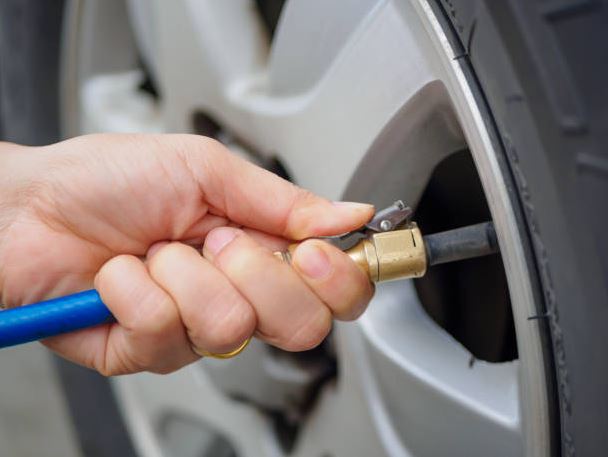Getting an air compressor model that’s up to the task is as important as inflating your car tire with the right pressure.
Tire inflation is one of the common uses of air compressors, but one of the most asked questions from many car owners is whether or not a 6-gallon air compressor will fill a car tire.
Well, most car tires require between 30 and 35 pounds per square inch (PSI) of air pressure, which a 6-gallon air compressor can easily produce. So yes, a 6-gallon air compressor can fill a car tire from the ground up.
Another reason this is so is that many 6-gallon compressors exceed the 1-2 CFM required for car tire inflation. But it also means you must wait for a refill when inflating a huge tire with a 6-gallon compressor.
To understand the tire’s specifications regarding the accurate air pressure required to inflate the tire, verifying the tire’s specifications in the manual are the same.
Table of Contents
How Long Will It Take a 6-Gallon Air Compressor to Fill Car Tires?
You can expect a 6-gallon compressor tank to fill a car tire from empty within 2 minutes to reach cut-out pressure, but it ultimately depends on the compressor model, the PSI, and the CFM of the compressor.
For example, 6-gallon compressors with a 150 PSI cut-out pressure will halt pumping once such pressure is reached. When the PSI falls below the cut-in pressure threshold, the pump will activate via a pressure switch trigger within 60 seconds.
How to Fill A Car Tire With 6 Gallon Air Compressor
First, you need the tools to fill a car tire with a 6-gallon air compressor easily.
These tools include the air compressor itself, a regulator, a pressure gauge, and, of course, a tire chuck. Once these tools are in place, follow these five steps:
Step 1: Confirm the PSI recommendation for your vehicle.
The first thing is to check the driver’s door sill to confirm the PSI recommendation. Since the subject focus is inflating car tires, this should be around 35 PSI and 32 PSI of air pressure for cold and hot tire pressure, respectively.
But you need 100 to 110 PSI of air pressure if you inflate tires on larger vehicles like tractors and trucks.
No matter what the case is, you should first verify the tire pressure for your vehicle’s tires from the driver’s side door sill sticker.
Step 2: Measure tire pressure with the gauge.
The next thing is to confirm whether the tire pressure is OK by removing the valve cap and then using the tire pressure gauge to measure the car’s tire pressure. You will need to move forward if you find less than the required amount.
Step 3: Power the 6-gallon air compressor
A power outlet with 12 volts or higher is best for powering the air compressor. If it’s rechargeable, you need a power outlet that can handle as much as 110 volts.
After checking the tire pressure, get the air compressor ready and connect it to the tire chuck with the tire valve. Here’s how:
Step 4: Make an airway with the tire chuck.
With the air compressor ready, connect it to the tire chuck and then make an airway by locking it with the tire valve to ensure the air goes right into the tire without any leaks.
Step 5: Inflate the tire and inspect the pressure gauge while at it.
Once you’ve secured the connection, please turn on the air compressor and keep your eyes on the pressure gauge to know when it meets the pressure requirements. By then, you can turn it off.
Also, after inflating, use the tire pressure gauge to check the tire pressure again. If it falls below par, then you need to inflate more.
Things To Consider When Selecting an Air Compressor To Fill Car Tire
Beyond the size of the tank, there are other factors to look out for when selecting an air compressor to fill your car tires, as these factors will ultimately determine which model is right for you.
First, you want to pay attention to the vehicle’s size. The larger the tires are, the more powerful the compressors and the longer the cycle time would need to be.
In addition, the air compressor’s PSI capability is another thing to look at. Most vehicles have tire PSI indicators alert the owner when the tires are low. The average car will require 35 PSI. This will help you determine if the compressor can handle your needs.
The air compressor cycle time reflects how much downtime an air compressor requires between cycles. While it varies by compressor model, it is generally a good idea to opt for an air compressor with a 50 percent duty cycle.
Another thing to consider when choosing an air compressor for your car tires is its power cord length. The longer the cord length, the longer power will have to travel to your car, and the more diluted it will be, constraining it from functioning at its highest potential.
Despite all these factors, the air compressor tank size will also dictate its run time and the PSI it can output. Hence, the bigger, the better.
Final Remark
There is nothing to be worried about when attempting to inflate your car tire with a 6-gallon air compressor. It is even worth it if you prioritize a solid portable compressor.
What you should be focused on is the model you go for. Some models offer higher CFM or PSI ratings for tools that require more power. You should use a 6-gallon air compressor if you need a basic compressor with good power and versatility.
When it comes to continuous-use applications, consider a larger, more powerful tank, which, of course, comes with a significant price hike but is ultimately worth it for its airpower.

